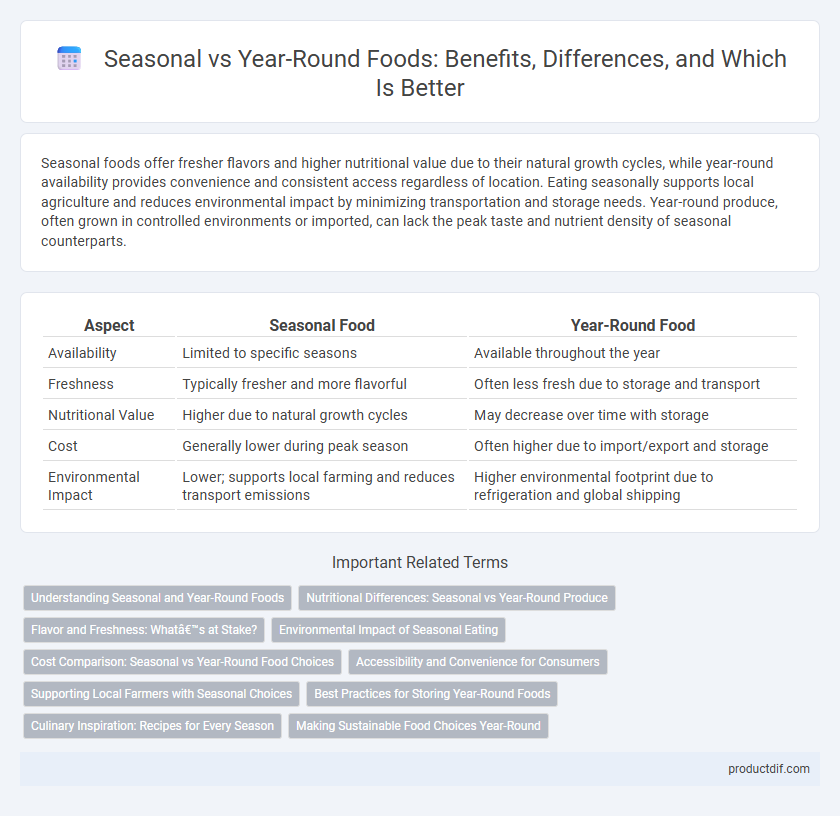Seasonal foods offer fresher flavors and higher nutritional value due to their natural growth cycles, while year-round availability provides convenience and consistent access regardless of location. Eating seasonally supports local agriculture and reduces environmental impact by minimizing transportation and storage needs. Year-round produce, often grown in controlled environments or imported, can lack the peak taste and nutrient density of seasonal counterparts.
Table of Comparison
| Aspect | Seasonal Food | Year-Round Food |
|---|---|---|
| Availability | Limited to specific seasons | Available throughout the year |
| Freshness | Typically fresher and more flavorful | Often less fresh due to storage and transport |
| Nutritional Value | Higher due to natural growth cycles | May decrease over time with storage |
| Cost | Generally lower during peak season | Often higher due to import/export and storage |
| Environmental Impact | Lower; supports local farming and reduces transport emissions | Higher environmental footprint due to refrigeration and global shipping |
Understanding Seasonal and Year-Round Foods
Seasonal foods are harvested at their peak during specific times of the year, offering maximum freshness, flavor, and nutritional value. Year-round foods, often grown in controlled environments or imported, provide consistency and availability regardless of natural growing cycles. Understanding the benefits and limitations of both seasonal and year-round foods helps consumers make informed choices about taste, quality, and sustainability.
Nutritional Differences: Seasonal vs Year-Round Produce
Seasonal produce often contains higher levels of vitamins and antioxidants due to being harvested at peak ripeness, unlike year-round produce which may be picked early and refrigerated for extended periods. The nutrient density in seasonal fruits and vegetables tends to be superior, enhancing flavor and health benefits. Consuming seasonal foods supports optimal nutrient intake aligned with natural growing cycles.
Flavor and Freshness: What’s at Stake?
Seasonal foods offer peak flavor and maximum freshness by being harvested at the height of ripeness, while year-round produce often sacrifices taste due to extended storage and long-distance transportation. Eating seasonally also supports nutrient density since these foods retain more vitamins and antioxidants compared to out-of-season alternatives. The choice between seasonal and year-round has a direct impact on culinary quality and nutritional value in your diet.
Environmental Impact of Seasonal Eating
Eating seasonal produce significantly reduces carbon emissions by minimizing transportation distances and the need for energy-intensive storage or artificial growing conditions. Year-round availability often relies on importing foods from distant regions or using greenhouses powered by fossil fuels, which increases the overall environmental footprint. Choosing seasonal foods supports local agriculture and biodiversity while conserving water and reducing pesticide use.
Cost Comparison: Seasonal vs Year-Round Food Choices
Seasonal food options often cost less due to local abundance and reduced transportation expenses, while year-round foods typically incur higher prices from importation and storage requirements. Price fluctuations align with harvest cycles, making seasonal produce more budget-friendly at peak times. Consumers can optimize food budgets by prioritizing seasonal items and supplementing with year-round staples as needed.
Accessibility and Convenience for Consumers
Seasonal foods offer peak freshness and nutritional value but can be limited in availability, affecting consistent access for consumers. Year-round produce, often made possible through modern preservation and global supply chains, ensures convenience and steady availability regardless of season. This constant accessibility supports meal planning flexibility and reduces the need for substitutions in recipes.
Supporting Local Farmers with Seasonal Choices
Choosing seasonal produce supports local farmers by aligning consumption with natural harvest cycles, reducing transportation emissions and spoilage. Year-round availability often relies on imports from distant regions, limiting economic benefits for nearby agricultural communities. Prioritizing seasonal foods fosters sustainable farming practices and strengthens regional food systems.
Best Practices for Storing Year-Round Foods
Storing year-round foods effectively requires maintaining consistent temperatures, preferably between 50degF to 70degF, and controlling humidity levels to prevent spoilage and mold growth. Using airtight containers and vacuum sealing preserves freshness by reducing exposure to air, moisture, and pests. Proper labeling with dates ensures rotation and minimizes waste, supporting sustainable food storage practices.
Culinary Inspiration: Recipes for Every Season
Seasonal ingredients offer peak flavor and nutritional value, inspiring chefs to create dishes that reflect the unique characteristics of each time of year. Year-round staples provide consistency and accessibility, enabling versatile recipes that adapt with the inclusion of fresh, seasonal produce. Combining seasonal elements with pantry essentials results in dynamic culinary creations that celebrate both tradition and innovation.
Making Sustainable Food Choices Year-Round
Choosing seasonal foods reduces the carbon footprint by minimizing transportation and storage energy, promoting local agriculture and biodiversity. Year-round consumption often relies on greenhouse-grown or imported produce, which increases greenhouse gas emissions and resource use. Emphasizing seasonal eating supports sustainable food systems and encourages nutrient-rich, fresher meals throughout the year.
seasonal vs year-round Infographic

 productdif.com
productdif.com